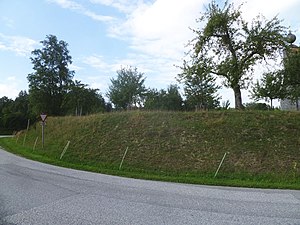Höft Castle
| Höft Castle | ||
|---|---|---|
|
Probable location of Höft Castle |
||
| Alternative name (s): | Höft lowland area | |
| Creation time : | 1109 (first documented mention) | |
| Castle type : | Niederungsburg | |
| Conservation status: | Burgstall | |
| Place: | Gaspoltshofen -Höft | |
| Geographical location | 48 ° 9 '57.6 " N , 13 ° 45' 2.8" E | |
|
|
||
The lost Höft castle is a lost moated castle in the municipality of Gaspoltshofen in the Grieskirchen district of Upper Austria (presumably on the site of the Catholic branch church St. Margaretha ).
history
The castle was first documented as a residence in 1109; the seat was originally protected by a pond. The builders of the small moated castle were the Stiller von Still und Heft, a free Bavarian aristocratic family. The first Stiller mentioned in a document was a Udalschalk who founded the Seitenstetten Abbey in 1109 and also dedicated goods to Höft. In 1120 he appeared together with Adalo von Stille as a witness to a donation to St. Nicola Abbey . 1130 an Egino de stille is mentioned in a document and around 1140 the noble man Gozolg ( Gozlodus nobilis homo de stillin ) belongs to the silent family . Other Stiller were: Dietmar and Luitpold von Stille (1180), Otto et otaker de stille (1215-1228), Ministeriale der Starhemberger , miles Heinrich von Stille (1264, 1268). Helmhart de stille received the Meierhof zu St. Georgen bei Grieskirchen from the Hochstift Passau ; he called himself Helmhardus de sanct Georgio for the first time in 1255 . This Helmhart is regarded as the progenitor of the Jörger . The property in Hausruck was summarized by the Seitenstetten Monastery under the Office Heft. In 1493 the Amt Heft was sold to Kaspar Pergheimer zu Würting .
Officials from the monastery were used for administration, the Seitenstetter magistrate Hans called himself von Heft as early as 1432 . He is considered to be the progenitor of the staplers, who stayed here for 133 years. The following are known as binders: Hans von Heft (1432), Wolfgang I von Heft (1465), Michael Hefter zu Heft, Benedikt Hefter zu Heft (1527) and Wolfgang II Hefter zu Heft (1565). In 1565 Achaz Innerseer, a cousin of Wolfgang, bought ownership of the stapler. In the middle of the 16th century this branch of the family had no male descendants and so the property went to Hans Adam Innerseer von Schmiding from a sideline. He called himself Schmieding, Innersee and Höft . The other heir Hans Paul († around 1600) had to sell Schmieding and Innersee in 1595 and he and his wife only had Höft.
In 1620 the dilapidated noble residence Höft, which was no longer inhabited after the death of Hans Paul Innerserse, was burned down during the occupation of Upper Austria by the soldiers of Duke Maximilian of Bavaria . As a result, the remaining walls were removed and the pond of the moated castle filled in. Around 1650 the rule of Höft came to Aistersheim .
Höft Castle today
The place of the noble seat Höft is still called "castle" in local parlance. To the east of the location of the subsidiary church of St. Margaret, which stands on a small hill, the original location of the stapler can be assumed. The lowland itself was completely leveled at the end of the 20th century.
literature
- Franz Buchinger: Gaspoltshofen . Market town office Gaspoltshofen, Gaspoltshofen 1995, ISBN 3-900963-20-7 .
- Georg Grüll : Castles and palaces in Upper Austria, Volume 2: Innviertel and Alpine foothills . Birken-Verlag, Vienna 1964.
- Irene Keller, Christian Keller: From Gebrulteskirch to Geboltskirchen: History of the community Geboltskirchen am Hausruck. Home register of the community of Geboltskirchen. Verlag Moserbauer, Ried im Innkreis 2009, ISBN 978-3-902684-08-0 .
- Walter Neweklowsky: Die castles. About the decay of our castles and palaces. In: Upper Austrian homeland sheets . Year 19, Issue 3/4, Linz 1965, pp. 3–38 ( online (PDF) in the forum OoeGeschichte.at).
- Christian K. Steingruber: A critical consideration of the historical-topographical manual of the fortifications and mansions of Upper Austria . Upper Austrian Provincial Archives , Linz 2013.
Individual evidence
- ↑ Steingruber, 2013, p. 110.

